by Steven
P. Pody and Joanne Wiertella
(click on photos to enlarge image)
ROMANCE IN METAL: WHEN LOVE, BEAUTY, DEVOTION AND MASS
PRODUCTION INTERTWINED
Valentine’s Day has, for more than six hundred years,
signified that special time for expressing one’s love.
It originated in recognition of St. Valentine, a bishop
martyred in 270 AD. He was known for going from house to
house, leaving food on the doorsteps of the poor.
Valentine’s Day became popular in England, Scotland and
France, evolving in significance over the years. Chaucer
and other early English poets wrote of the country "notion"
that birds chose their mates on this day.
| |
VALENTINE'S DAY
Muse, bid the morn awake,
Sad winter now declines,
Each bird doth choose a mate
This day - St. Valentine's;
For that good bishop's sake
Get up, and let us see,
What beauty it shall be
That fortune us assigns.
Drayton (1563-1631)
|
|
Valentine’s Day, like love itself, was as popular
among the lower classes as it was at many European
courts. On St Valentine’s Eve in Scotland, young people
assembled and wrote the names of their acquaintances on
slips of paper, placing the names of young men and
maidens in separate bags. The maidens drew from the
former, the young men from the latter, three times in
succession (returning the names after the first and
second drawings). Legend said that if one took out the
same name three times consecutively, that person would
become the future husband or wife.
A custom of the time also suggests that the younger
people in a household were allowed, early in the morning,
to catch some senior relative or a friend of the family,
and utter the salutation, "Good morrow, Valentine." It
was then expected that a present would be offered.
On St. Valentine’s morning, young British women would
look through the keyhole of the house door. If they saw
only a single object or person, they would remain
unmarried all that year. If they saw, however, two or
more objects or persons, they would be sure to have a
sweetheart; but, if by chance they saw a cock and a hen,
they might be quite certain of being married before the
year was out.
The "Valentine" as a note or letter appeared in the 15th
century - one of the first documented instances being a
drawing of a knight and lady, with Cupid in the act of
sending an arrow to pierce the knight’s heart. The
invention of the printing press and spread of printed
materials had increased common literacy. So, by the 17th
century, people of all classes were exchanging notes
expressing various degrees of heart-felt admiration. And
thanks to a formal postal system in the 1850’s, American
Esther Howland’s first mass-produced Valentine cards,
Valentine’s Day had become quite a "showy affair."
While the profusion of Valentine’s cards today is
commonplace, it was the advent of the Romantic Movement
in English literature at the end of the 18th century
that laid the groundwork for just such a romantic
holiday. The Romantic Movement took the passionless
logic, rationalism and pragmatic spirit of the 18th
century "enlightenment" and replaced it with emotion,
romantic love, and appreciation of the beauties and
wonders of the world. The grandeur to which the
individual and all human kind were capable became
anchors to a humanizing counter-reaction to the
utilitarian hard reason, science and expanding
industrialization. This was a major influence on the
arts and would eventually lead to more emotion-based
decorative motifs such as Rococo and Art Nouveau.
Enduring gifts such as jewel boxes with symbolic
embellishments became popular. Cast in metal and
finished with gold or silver, these elaborate boxes
conveyed the wonderful message "I love you."
 |
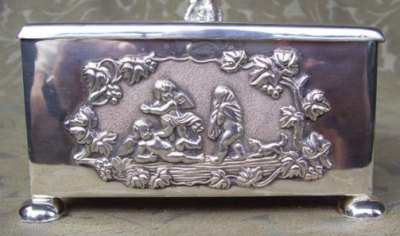 |
Poppy Heart Jewel Case: 1910; 4 ¼ x 4
½ x 2¾”h;
possibly The Art Metal Works
|
box with cherubs decoration
|
Cupids, cherubim, hearts and other symbols were
employed to render an unmistakable and permanent message
that a pretty jewelry box was such a gift. Better than a
letter or a singing telegram, a jewelry box in the
boudoir, where it could be viewed daily, was a permanent
testament and purposeful reminder of affection, as well
as a delight to the eye.
When we think of Valentine’s Day today, we envision
Roses, Cupid with his golden tipped arrows, and Hearts
be-decked with ribbons. What we may have forgotten, is
the very rich history behind these and other symbols of
love.
For example, the heart has long been considered in many
cultures to be the seat of human emotions representing
energy, devotion, health, and the innermost self. In the
earliest of times, the heart shape we now commonly
accept, was seen on the seed pod of the Silphium plant -
a long extinct type of fennel. This rare plant had
medicinal uses that were so valuable that the Greeks
believed it to be a gift from Apollo.
Hearts as symbols of "love" date from the late medieval
period.
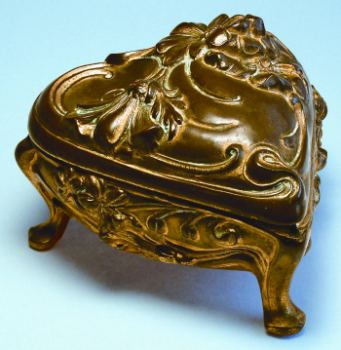 |
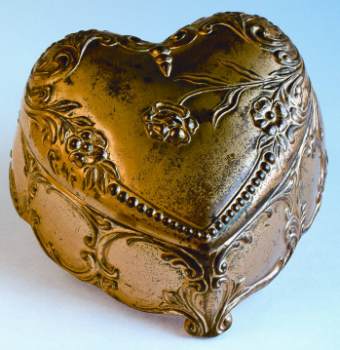 |
Ring Box with Rosebud: c1911;
2 x 1 ¾ x 1 ½”h; Manufacturer Unknown
|
Rose and Wild Roses Handkerchief Box:
c1913;
6 ½ x 6 ½ x 3”h; Manufacturer Unknown
|
The Rose, "Queen of Flowers", has been a favorite
throughout history for its perfect beauty. The rose was
native to Europe, Asia, Africa, and the Americas. It was
diligently cultivated by the ancients, especially by the
Romans. Stories abound regarding the special-ness of
this flower: According to a fable, the color of the red
rose may be traced to Venus. When she was hastening to
the relief of her beloved Adonis, her delicate foot was
pierced by a thorn that drew blood.
A legend of St. Francis of Assisi relates that as he was
once shivering in his room in the depths of winter, a
demon whispered in his ear suggestions of ease and
luxury. He fought the temptations by going outside and
rolling in the snow on a heap of thorns. From these
thorns, sprinkled with his blood, sprang Roses of
Paradise.
Still another legend suggests that Cupid, while leading
a dance in heaven, stumbled and overturned a bowl of
nectar which, falling upon the earth, colored the rose.
Has there ever been a flower which so universally and
constantly represents one idea - that of love - as the
rose? It is still the ultimate emblem of true affection,
love, poetry and beauty. Cupid is another popular image
of love. Today, we most commonly remember him from both
Greek and Roman mythology as the son of the Goddess of
Love. In those times of mythology, there lived a king
whose three daughters were world-renowned for their
matchless beauty. Psyche, the youngest daughter, was so
lovely that the king’s subjects offered to pay homage to
her, rather than Venus as the Goddess of Beauty. In her
jealously, Venus commanded her son Cupid to slay Psyche. Armed
with his bow and arrows tipped with a deadly poison,
Cupid set out to do his mother’s bidding. At nightfall,
Cupid crept noiselessly into Psyche’s room and
approached the couch where she slept. As he was about to
administer the poison, a moonbeam fell upon her lovely
face and caused Cupid to pause in surprise. As he did
so, one of his love arrows pierced his own rosy flesh,
and he fell deeply in love.
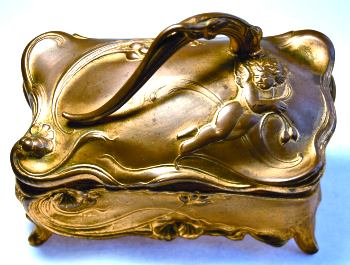 |
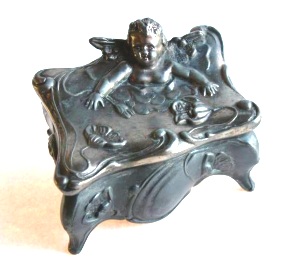 |
Nouveau Cupid with Pond Lily: 1906;
5 ¼ x 3 x 3 ¾”h; Weidlich Bros Mfg Co
|
Nouveau Cherub with Poppy Jewel Case:
1907;
4 ½ x 3 ½ x 2 ¼”h; NB Rogers Silver Plate Co
|
Even before the Romans and Greeks, some saw Cupid as
one of the most ancient of the deities, and thought that
he had no parents, but succeeded immediately from Chaos.
Others thought that Night (Nox) produced an egg which,
having hatched under her wings, brought forth Cupid who,
with golden wings, immediately flew throughout the whole
world. Cupid was usually represented naked, to show that
love had nothing of its own. He was armed with a bow and
quiver full of darts to show his power of the mind, and
crowned with roses to show the delightful but transitory
pleasures he bestows. Sometimes he was depicted blind,
to denote that love sees no faults in the object beloved.
He was always drawn with wings to symbolize that nothing
is more fleeting than the passion he excites.
It was in the 16th century that angels were first
pictured as humans with wings. Angels were considered to
be messengers of God. At that time, "cherub" was the
proper name of an angel but, by the 18th century,
cherubs came to be represented as beautiful and innocent
children (or child’s head) between a pair of wings.
Their celestial and protective features were "a natural"
as a decorative motif on Valentines.
 |
 |
Standing Cupid with Water Lily: 1907;
4 ½ x 3 ¼ x 5"h; Manufacturer Unknown
|
Rococo Jewel Casket: 1910;
7 ¾ x 6 ½ x 4 ¾"h; possibly Brainard &
Wilson Corp
|
Another formerly common symbol of love, now mostly
reduced to a symbol of remembrance, was the Poppy. It
seems to have a long tradition of symbolizing fertility,
regeneration and renewal, as well as remembrance.
Another aspect that makes the poppy important is its
very commonness. It grows virtually anywhere, and its
juice was frequently administered to induce sleep and
relieve pain. The ancients, who regarded sleep as the
great physician and consoler of human nature, crowned
Morpheus, the God of Sleep, with a wreath of poppies.
The many seeds of the poppy emphasize its fertility, and
nature’s constant cycle of rejuvenation - in other words,
the essence of memory and hope.
All these symbols, the Rose, Cupid, the Heart, Poppies
and Cherubs, lavishly adorned the art metal jewelry
boxes of yesteryear. There was heartfelt meaning
attached to these precious gifts, and they were received
as significant symbols of enduring love. A lady’s jewel
box was one of her most cherished possessions. For that
reason, we still find that these lovely boxes have been
held in families for a hundred years!
Now we can better understand why.
|
Steven P. Pody
Specialist Jewelry Caskets/Boxes of the Art Nouveau
Period
Joanne Wiertella - contact:
jewelboxbook@sbcglobal.net
author of "The Jewel Box Book: The Definitive Guide to
American Art Metal Jewelry Boxes 1900-1925"
208 pages - full color book - more information available
at
www.jewelboxbook.com
- 2007 -
|
|
|
 ASSOCIATION OF SMALL COLLECTORS OF ANTIQUE SILVER
ASSOCIATION OF SMALL COLLECTORS OF ANTIQUE SILVER ASSOCIATION OF SMALL COLLECTORS OF ANTIQUE SILVER
ASSOCIATION OF SMALL COLLECTORS OF ANTIQUE SILVER